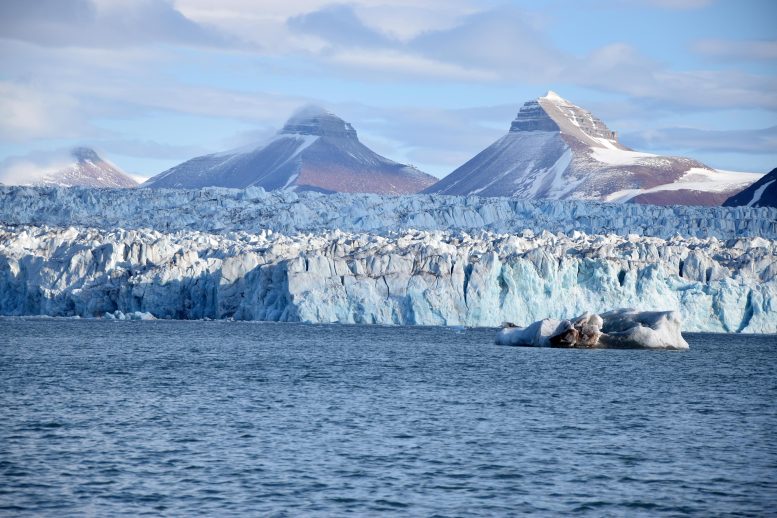
An international group of researchers has pieced together the recent history of ocean warming at the gateway to the Arctic Ocean in an area called the Fram Strait, between Greenland and Svalbard, and found that the Arctic Ocean has been warming since much longer than earlier recordings suggested. 1 credit
The Arctic Ocean has been warming since the beginning of the 20e century – decades earlier than the records suggest – due to warmer water flowing into the delicate polar ecosystem from the Atlantic Ocean.
An international group of researchers has pieced together the recent history of ocean warming at the gateway to the Arctic Ocean in a region called the Fram Strait, between Greenland and Svalbard.
Using chemical signatures found in marine microorganisms, researchers found that the Arctic Ocean began to warm rapidly at the turn of the last century as warmer, saltier waters poured in from the Atlantic – a phenomenon called atlantification – and that this change probably preceded global warming. documented by modern instrumental measurements. Since 1900, the temperature of the ocean has increased by about 2 degrees Celsiusas sea ice retreated and salinity increased.
The results, reported in the journal Scientists progress, provide an early historical perspective on the Atlantic Ocean’s Atlanticification and reveal a much stronger connection to the North Atlantic than previously thought. The connection is capable of shaping Arctic climate variability, which could have important implications for sea ice retreat and sea level rise globally as the polar ice caps continue to to melt.
Using chemical signatures found in marine microorganisms, researchers have found that the Arctic Ocean began to warm rapidly at the turn of the last century as warmer, saltier waters poured in from the Atlantic – a phenomenon called Atlanticification. 1 credit
All of the world’s oceans are warming due to climate change, but the Arctic Ocean, the smallest and shallowest of the world’s oceans, is warming the fastest.
“The rate of warming in the Arctic is more than double the global average, due to feedback mechanisms,” said co-lead author Dr Francesco Muschitiello from Cambridge’s Department of Geography. “Based on satellite measurements, we know that the Arctic Ocean has warmed steadily, particularly over the past 20 years, but we wanted to put the recent warming into a longer context.”
Atlanticification is one of the causes of Arctic warming, but instrumental records that can track this process, such as satellites, only date back about 40 years.
As the Arctic Ocean warms, it melts the ice in the polar region, which in turn affects global sea levels. As the ice melts, it exposes more of the surface of the ocean to the sun, releasing heat and raising the air temperature. As the Arctic continues to warm, it will melt permafrost, which stores huge amounts of methane, a greenhouse gas far more harmful than carbon dioxide.
The researchers used geochemical and ecological data from ocean sediments to reconstruct how the properties of the water column have changed over the past 800 years. They accurately dated the sediments using a combination of methods and looked for diagnostic signs of Atlanticification, such as changes in temperature and salinity.
“When we looked at the entire 800-year time scale, our temperature and salinity records seem pretty consistent,” said co-lead author Dr Tesi Tommaso from the Institute of Polar Sciences in the United States. National Research Council in Bologna. “But all of a sudden at the beginning of the 20e century you get this marked change in temperature and salinity – it really stands out.
“The reason for this rapid atlantification at the gateway to the Arctic Ocean is intriguing,” Muschitiello said. “We compared our results with the ocean circulation at lower latitudes and found that there is a strong correlation with the slowing of dense water formation in the Labrador Sea. In a future warming scenario, the circulation deep in this subpolar region is projected to shrink further due to thawing of the Greenland Ice Sheet.Our results imply that we might expect further Arctic atlantification in the future due to climate change.
The researchers say their results also expose a possible flaw in climate models, as they do not replicate this early Atlanticification from the turn of the last century.
“Climate simulations generally do not reproduce this type of warming in the Arctic Ocean, which means that the understanding of the mechanisms driving Atlanticification is incomplete,” Tommaso said. “We rely on these simulations to project future climate change, but the absence of any signs of early warming in the Arctic Ocean is a missing piece of the puzzle.”
Reference: “Rapid Atlanticification along the Fram Strait in the early 20th century” by Tommaso Tesi, Francesco Muschitiello, Gesine Mollenhauer, Stefano Miserocchi, Leonardo Langone, Chiara Ceccarelli, Giuliana Panieri, Jacopo Chiggiato, Alessio Nogarotto, Jens Hefter, Gianmarco Ingrosso , Federico Giglio, Patrizia Giordano and Lucilla Capotondi, November 24, 2021, Scientists progress.
DOI: 10.1126/sciadv.abj2946
Francesco Muschitiello is a Fellow of Sidney Sussex College, Cambridge.

/cloudfront-us-east-1.images.arcpublishing.com/gray/HAQHVR4PTFEPFIE77LUEQ2PR7I.jpg)
